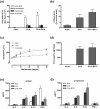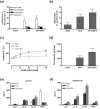Lifetime-dependent effects of bisphenol A on asthma development in an experimental mouse model
- PMID: 24950052
- PMCID: PMC4065062
- DOI: 10.1371/journal.pone.0100468
Lifetime-dependent effects of bisphenol A on asthma development in an experimental mouse model
Abstract
Background: Environmental factors are thought to contribute significantly to the increase of asthma prevalence in the last two decades. Bisphenol A (BPA) is a xenoestrogen commonly used in consumer products and the plastic industry. There is evidence and an ongoing discussion that endocrine disruptors like BPA may affect human health and also exert alterations on in the immune system. The aim of this study was to investigate age-dependent effects of BPA on the asthma risk using a murine model to explain the controversial results reported till date.
Methods: BALB/c mice were exposed to BPA via the drinking water for different time periods including pregnancy and breastfeeding. To induce an asthma phenotype, mice were sensitized to ovalbumin (OVA), followed by an intrapulmonary allergen challenge.
Results: BPA exposure during pregnancy and breastfeeding had no significant effect on asthma development in the offspring. In contrast, lifelong exposure from birth until the last antigen challenge clearly increased eosinophilic inflammation in the lung, airway hyperreactivity and antigen-specific serum IgE levels in OVA-sensitized adult mice compared to mice without BPA exposure. Surprisingly, BPA intake during the sensitization period significantly reduced the development of allergic asthma. This effect was reversed in the presence of a glucocorticoid receptor antagonist.
Conclusions: Our results demonstrate that the impact of BPA on asthma risk is strongly age-dependent and ranges from asthma-promoting to asthma-reducing effects. This could explain the diversity of results from previous studies regarding the observed health impact of BPA.
Conflict of interest statement
Figures





Similar articles
-
Fetal exposure to bisphenol A as a risk factor for the development of childhood asthma: an animal model study.Environ Health. 2012 Feb 21;11:8. doi: 10.1186/1476-069X-11-8. Environ Health. 2012. PMID: 22353195 Free PMC article.
-
The effects of maternal exposure to bisphenol A on allergic lung inflammation into adulthood.Toxicol Sci. 2012 Nov;130(1):82-93. doi: 10.1093/toxsci/kfs227. Epub 2012 Jul 21. Toxicol Sci. 2012. PMID: 22821851 Free PMC article.
-
Maternal bisphenol a exposure promotes the development of experimental asthma in mouse pups.Environ Health Perspect. 2010 Feb;118(2):273-7. doi: 10.1289/ehp.0901259. Environ Health Perspect. 2010. PMID: 20123615 Free PMC article.
-
Bisphenol A: A Concise Review of Literature and a Discussion of Health and Regulatory Implications.In Vivo. 2019 Sep-Oct;33(5):1421-1423. doi: 10.21873/invivo.11619. In Vivo. 2019. PMID: 31471387 Free PMC article. Review.
-
Bisphenol A, an endocrine-disruptor compund, that modulates the immune response to infections.Front Biosci (Landmark Ed). 2021 Jan 1;26(2):346-362. doi: 10.2741/4897. Front Biosci (Landmark Ed). 2021. PMID: 33049673 Review.
Cited by
-
Prenatal exposure to bisphenol A and risk of allergic diseases in early life.Pediatr Res. 2017 Jun;81(6):851-856. doi: 10.1038/pr.2017.20. Epub 2017 Jan 31. Pediatr Res. 2017. PMID: 28141789
-
CLARITY-BPA academic laboratory studies identify consistent low-dose Bisphenol A effects on multiple organ systems.Basic Clin Pharmacol Toxicol. 2019 Aug;125 Suppl 3(Suppl 3):14-31. doi: 10.1111/bcpt.13125. Epub 2018 Oct 17. Basic Clin Pharmacol Toxicol. 2019. PMID: 30207065 Free PMC article. Review.
-
Prenatal bisphenol A and S exposure and atopic disease phenotypes at age 6.Environ Res. 2023 Jun 1;226:115630. doi: 10.1016/j.envres.2023.115630. Epub 2023 Mar 6. Environ Res. 2023. PMID: 36889565 Free PMC article.
-
Associations of prenatal environmental phenol and phthalate biomarkers with respiratory and allergic diseases among children aged 6 and 7 years.Environ Int. 2018 Jun;115:79-88. doi: 10.1016/j.envint.2018.03.016. Epub 2018 Mar 20. Environ Int. 2018. PMID: 29550712 Free PMC article.
-
Developmental Bisphenol A Exposure Modulates Immune-Related Diseases.Toxics. 2016 Sep 26;4(4):23. doi: 10.3390/toxics4040023. Toxics. 2016. PMID: 29051427 Free PMC article. Review.
References
-
- Umetsu DT, McIntire JJ, Akbari O, Macaubas C, DeKruyff RH (2002) Asthma: an epidemic of dysregulated immunity. Nat Immunol 3: 715–720. - PubMed
-
- Pearce N, Douwes J (2006) The global epidemiology of asthma in children. Int J Tuberc Lung Dis 10: 125–132. - PubMed
-
- Vaidya SV, Kulkarni H (2012) Association of urinary bisphenol A concentration with allergic asthma: results from the National Health and Nutrition Examination Survey 2005–2006. J Asthma 49: 800–806. - PubMed
Publication types
MeSH terms
Substances
LinkOut - more resources
Full Text Sources
Other Literature Sources
Medical

